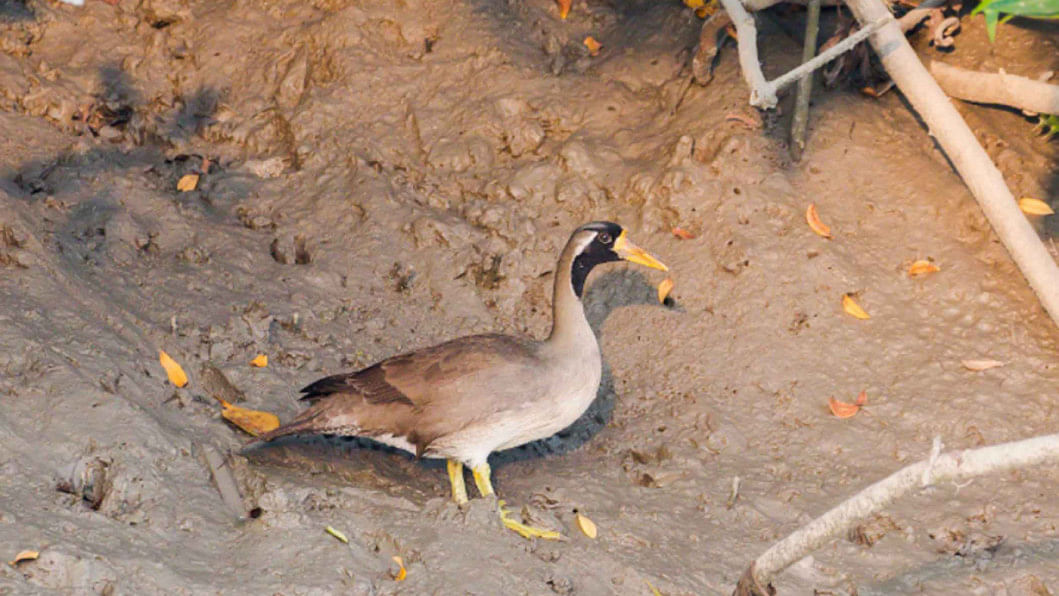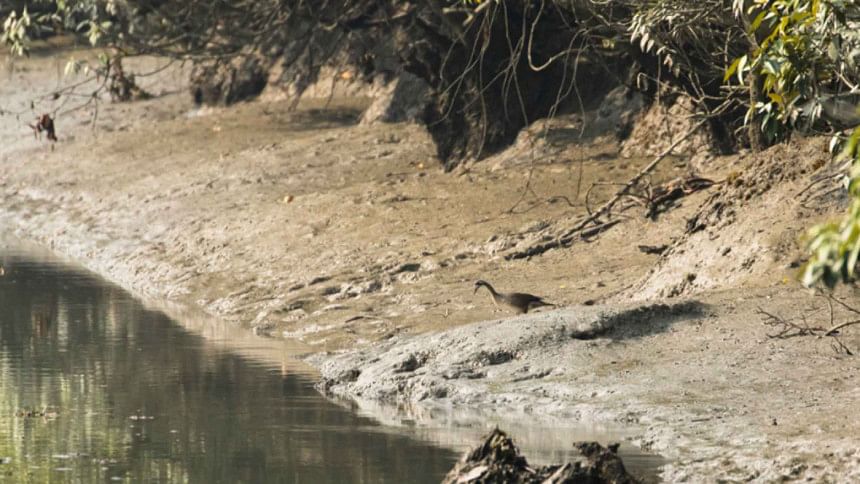Masked finfoot under threat: A canary in the coalmine of climate change

The story of the masked finfoot first caught my attention in 2013. Just like most other wild animals, the news on this recluse bird that calls the Sundarbans its home was not promising.
Each time I write about environmental issues, I am left wondering: Why should the extinction of some bird, a tiny butterfly or a giant elephant bother us? I mean, if you are looking for a dose of nature, you can simply cosy up on your sofa and turn on Planet Earth. They have even managed to bring to life, albeit on TV, the prehistoric dinosaurs.
But I worry. I worry that the next generation, if it gets to survive the climate apocalypse, will not know the joys and perils of a life in the wilderness. That we have moved so far from nature that our only way to feel connected to it is by taking a weekend away from the city and paying money to enter forests.
I will leave the conversation over nature being contained in enclosed spaces or for small weekend getaways for another time. For now, I want to pen yet another plea, another call for help to change the course we are running on. And I want to tell you why the loss of a bird somewhere far away from home should bother you.
This year's theme for World Environment Day, observed on June 5, was "Only One Earth," which begs to look at the natural world through both a micro- and a macro-lens.
Everything is connected. Take, for example, the car you are driving or being driven in, or how about the factory you run or the one you work in. The energy and fuel that it uses, the pollution it creates, the pressure it puts on natural resources and everything the environment has to supply you with to keep the wheels turning affects the environment around you.
A species threatened like no other
There are a few other species of birds in Asia that could be considered as threatened as the iconic masked finfoot, currently listed as "endangered" on the International Union for Conservation of Nature (IUCN) Red List. Globally, there are only three species of finfoots across the tropics of Asia, Africa and the Americas. Asia's masked finfoot is the least known of the three, and considered the most imperilled.
The IUCN recategorised masked finfoot from "vulnerable" to "endangered" in 2009 as rates of population decline were found to be higher than previously assumed, owing to the destruction and disturbance of its habitats and, to a lesser extent, hunting and collection of eggs and chicks.
This shy and reclusive water bird, which can climb trees with its waders and swim the waters, has taken many a photographer and ornithologist deep into the labyrinth of the tide-country.
A scientific paper published in the UK-based ornithological journal Forktail: Journal of Asian Ornithology revealed a very small, declining global population of the masked finfoot.
The paper, titled "The status and distribution of the masked finfoot 'In nature, nothing exists alone''In nature, nothing exists alone' – Asia's next avian extinction?" was authored by a team of conservation scientists and bird experts from the University of Cambridge, BirdLife International, Wildlife Conservation Society, and Mahidol University.
Available data compiled across all countries where finfoot is found indicates that the present population may not exceed 304 adult individuals, and could be as low as 108 individuals. And the vast majority of these individuals are likely concentrated in the Sundarbans' Bangladesh side, according to the research paper.
While previously believed to be also found in Cambodia, India, Laos, Malaysia, Myanmar, Singapore, Thailand and Vietnam, most countries now report either a declining population or can only cite historical sightings, with breeding populations only existing in Cambodia and Myanmar apart from Bangladesh.
Even though BirdLife International considers the species endangered, the authors in this paper argue that, given its current status, the masked finfoot should be considered critically endangered and heading towards extinction.
The masked finfoot of the Sundarbans – that is what I will call it now, because this may very well be its last known address – is just a reminder of habitat degradation in Bangladesh's largest forest body. It is estimated that the eastern part of the Sundarbans currently supports between 40 and 80 breeding pairs, but with a declining population trend, according to the Bangladeshi lead author of the paper, Sayam U Chowdhury.
Threats faced by the species in Bangladesh include poison fishing, the collection of eggs and chicks from nests by fishermen, and the impacts of rising sea levels such as saltwater intrusion in key habitats, leading to a reduced freshwater supply.

There has been a sharp decline of masked finfoot population in the coastal parts of the Sundarbans concomitant with a shift of nesting habitats towards less saline areas closer to the landward edge of the forest. And at the landward edge, habitat destruction and human footprint – namely industries – inching towards the fringes of the Sundarbans, increased motorised vessel traffic, and just an overall rise in human movement within the forest premises threaten the balance of nature.
Based on field surveys, the masked finfoot population in Bangladesh is estimated to be 80–160 mature individuals. That is a huge number as it constitutes 52.6-75 percent of the global population, which is estimated to be around 108–304 individuals. This also shines a light upon the overwhelming importance of conserving this population in the Sundarbans at the global level.
We all think about tigers when it comes to the Sundarbans, but the masked finfoot is far more threatened and elusive than the tigers. If we lose the Sundarbans, it is very likely that we will lose this bird from the face of the Earth.
Saving this population and their habitat could mean turning around the clock on this species' fate on Earth. The masked finfoot depends on low-lying, undisturbed areas of forested wetlands, especially river channels with formerly little or no human activity. This is something that is still possible in the Sundarbans.
The research paper ends with a reminder that the recommendations made two decades ago by BirdLife International (2001) remain relevant to this day. The masked finfoot appears to be the harbinger of doom if meaningful actions are not taken at each step. Measures need to be taken on all fronts. Global action to protect the planet from further impacts of climate change, something that would ensure that ice caps don't melt at the rate they are now, which would then ensure that the sea level does not rise further, which would in turn ensure that salinity does not increase in the Sundarbans any more, thus not reducing suitable habitat for the masked finfoot.
Meanwhile, we must do everything we can in the Sundarbans to reduce immediate threats. Widespread use of poison fishing, habitat degradation, water vessel traffic, disturbance from a growing tourist load and natural resource harvesters, and increased pressure on the Sundarbans for its resources to build and support factories around the tidal network must all be addressed nationally.
The masked finfoot is essentially the barometer of success, of not just Bangladesh's fight against encroachment into natural resources, but of the global fight against climate change.
'In nature, nothing exists alone'
To make things a little clearer, let me break down this issue further. The natural world, for lack of better metaphor, can sometimes act like a carefully constructed domino castle. If we threaten the footing of one tile, we effectively set off a chain reaction. This particular bird, its home the Sundarbans, and us – we are all in it together.
Remember Rachel Carson's Silent Spring? And how it launched an environmental movement, reminding us that one action can affect everything – from flora, fauna to us humans (somehow, we exist outside the realm of fauna, and maybe that's the problem)? The case of the masked finfoot is like taking a page out of Carson's book, which reminds us that "in nature, nothing exists alone."
It is time to recalibrate our environmental agenda – both on a personal and a policy level – and to keep telling ourselves that if a bird is affected now, then you will be too in due time.
Abida Rahman Chowdhury is a journalist at The Daily Star with interests in wildlife and biodiversity conservation.

 For all latest news, follow The Daily Star's Google News channel.
For all latest news, follow The Daily Star's Google News channel. 








Comments